
How Can Schools Effectively Implement SEL?
Implementing SEL effectively requires a strategic, school-wide approach that involves educators, students, families, and the community. This guide outlines best practices, challenges, and solutions for integrating SEL into schools.
Key Strategies for Implementing SEL in Schools
1. Embed SEL into Daily Instruction
✔ Integrate SEL with Core Subjects – Link SEL themes to literature, social studies, and science lessons. ✔ Use Cooperative Learning Techniques – Group activities promote teamwork, communication, and empathy. ✔ Encourage Reflective Practices – Journaling, role-playing, and storytelling help students process emotions and social situations. ✔ Incorporate Mindfulness & Stress Reduction – Teach breathing exercises and relaxation techniques.
📖 Real-World Example: A middle school in Boston integrated SEL discussions into English and history classes, leading to higher student engagement and better classroom discussions on ethical decision-making.
2. Create a Positive School Culture
✔ Start Each Day with SEL Check-Ins – Morning meetings help students express emotions and set a positive tone. ✔ Develop Peer Mentoring Programs – Older students mentor younger ones to reinforce SEL skills. ✔ Promote Restorative Practices – Replace punitive discipline with reflection-based conflict resolution strategies. ✔ Celebrate SEL Milestones – Recognize students who demonstrate strong SEL competencies.
📖 Real-World Example: A school district in San Francisco introduced morning mindfulness sessions, reducing student stress and increasing classroom focus.
3. Provide Teacher Training & Support
✔ Offer Professional Development on SEL – Train educators to model and teach SEL effectively. ✔ Encourage Self-Care for Educators – Teachers benefit from mindfulness, emotional regulation techniques, and peer support groups. ✔ Use SEL Coaching & Mentorship – Create peer mentorship among teachers for SEL best practices. ✔ Develop SEL-Focused Teaching Strategies – Help educators integrate SEL into lesson planning and classroom management.
📖 Real-World Example: A high school in Chicago implemented monthly SEL training workshops, improving teacher-student relationships and reducing disciplinary incidents.
4. Engage Families & Communities in SEL
✔ Host SEL Family Nights – Provide parents with resources to support SEL at home. ✔ Send SEL Newsletters – Share strategies, conversation starters, and activities families can practice together. ✔ Partner with Local Organizations – Collaborate with libraries, youth groups, and mental health professionals to expand SEL access. ✔ Encourage Parent Involvement – Create advisory committees where parents can contribute to SEL initiatives.
📖 Real-World Example: A school district in Denver partnered with local mental health organizations to offer SEL training for families, whichimproved student emotional regulation at home and school.
Challenges & Solutions in SEL Implementation
1. Time Constraints in Curriculum
❌ Schools struggle to fit SEL into already-packed academic schedules. ✅ Solution: Embed SEL into existing subjects rather than treating it as an extra lesson.
2. Measuring SEL Progress
❌ SEL growth is more complicated to quantify than academic skills. ✅ Solution: Use student self-assessments, teacher observations, and behavioral tracking.
3. Resistance from Stakeholders
❌ Some educators and parents may not fully understand SEL’s importance. ✅ Solution: Provide evidence-based research showing SEL’s impact on academic and personal success.
Action Steps for Schools to Implement SEL
✔ Develop a School-Wide SEL Vision – Align SEL with the school’s mission and goals. ✔ Offer SEL Training for Educators & Staff – Ensure teachers have the tools to integrate SEL into their classrooms. ✔ Foster a Supportive Learning Environment – Encourage peer collaboration and classroom emotional safety. ✔ Partner with Parents & Communities – Extend SEL learning beyond the classroom. ✔ Monitor & Assess SEL Impact – Use data to refine and enhance SEL strategies.
📥 Download: SEL Implementation Guide for Schools – A step-by-step resource for educators and administrators.
📌 Join Our Upcoming SEL Webinar for Educators! – Gain insights from SEL experts on best practices.
Conclusion
Implementing SEL in schools is a transformative step toward building resilient, emotionally intelligent, and academically successful students. Schools can create an inclusive and supportive learning environment by embedding SEL into daily instruction, fostering a positive school climate, training teachers, and engaging families.
Would you like customized SEL implementation resources for your school? Let us know how we can help! 🚀
Find out more at www.seltrove.com
Want to learn more?
Access classroom-ready turnkey resources for your SEL classroom. Our SEL resources are crafted to be both engaging and interactive, aimed at nurturing empathy, compassion, and well-being among students. With a commitment to creating inclusive and kind classroom environments, our suite of print and digital materials is designed to support educators in this mission
Featured links
-
SEL Print Workbooks
-
SEL Lightspeed Schoolwide
-
SEL K-12 Free Sample Guide
-
District Solutions
-
About us
Teacher Resources
Get in touch
-
516 North Ogden Ave, Suite 111 Chicago, IL 60642
-
andy@seltrove.com
-
312-224-2536